Lifan Luo
Master Rules from Chaos: Learning to Reason, Plan, and Interact from Chaos for Tangram Assembly
May 17, 2025Abstract:Tangram assembly, the art of human intelligence and manipulation dexterity, is a new challenge for robotics and reveals the limitations of state-of-the-arts. Here, we describe our initial exploration and highlight key problems in reasoning, planning, and manipulation for robotic tangram assembly. We present MRChaos (Master Rules from Chaos), a robust and general solution for learning assembly policies that can generalize to novel objects. In contrast to conventional methods based on prior geometric and kinematic models, MRChaos learns to assemble randomly generated objects through self-exploration in simulation without prior experience in assembling target objects. The reward signal is obtained from the visual observation change without manually designed models or annotations. MRChaos retains its robustness in assembling various novel tangram objects that have never been encountered during training, with only silhouette prompts. We show the potential of MRChaos in wider applications such as cutlery combinations. The presented work indicates that radical generalization in robotic assembly can be achieved by learning in much simpler domains.
Learning thin deformable object manipulation with a multi-sensory integrated soft hand
Nov 21, 2024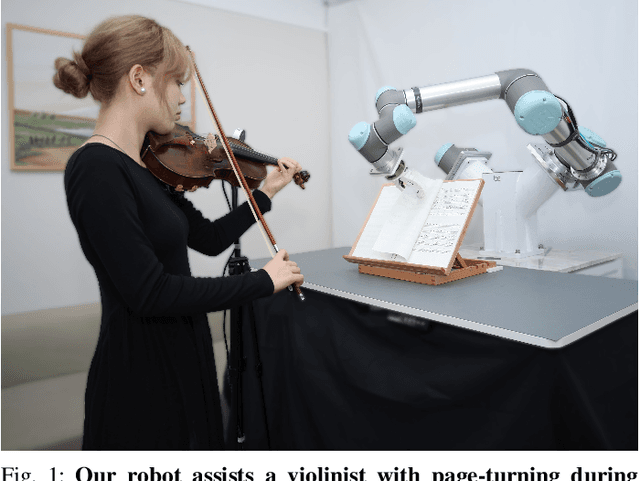
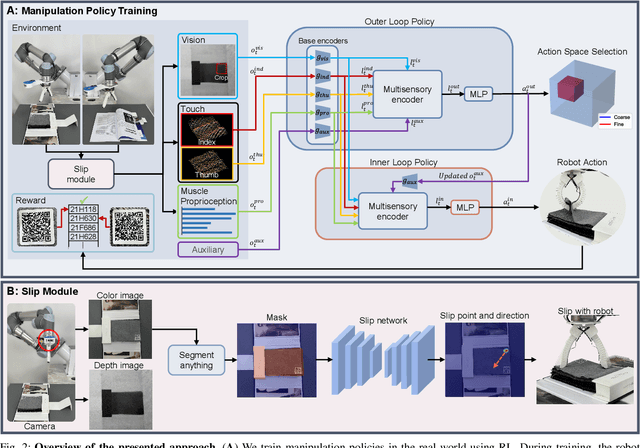
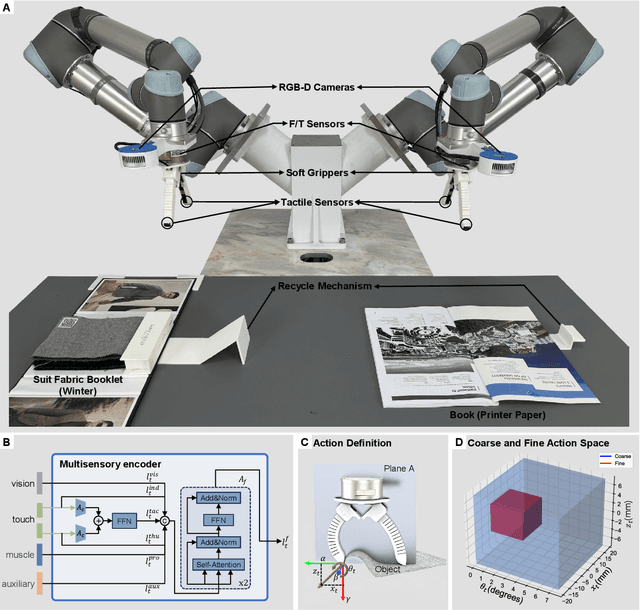
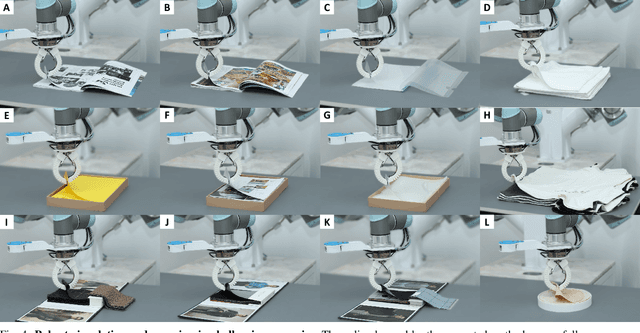
Abstract:Robotic manipulation has made significant advancements, with systems demonstrating high precision and repeatability. However, this remarkable precision often fails to translate into efficient manipulation of thin deformable objects. Current robotic systems lack imprecise dexterity, the ability to perform dexterous manipulation through robust and adaptive behaviors that do not rely on precise control. This paper explores the singulation and grasping of thin, deformable objects. Here, we propose a novel solution that incorporates passive compliance, touch, and proprioception into thin, deformable object manipulation. Our system employs a soft, underactuated hand that provides passive compliance, facilitating adaptive and gentle interactions to dexterously manipulate deformable objects without requiring precise control. The tactile and force/torque sensors equipped on the hand, along with a depth camera, gather sensory data required for manipulation via the proposed slip module. The manipulation policies are learned directly from raw sensory data via model-free reinforcement learning, bypassing explicit environmental and object modeling. We implement a hierarchical double-loop learning process to enhance learning efficiency by decoupling the action space. Our method was deployed on real-world robots and trained in a self-supervised manner. The resulting policy was tested on a variety of challenging tasks that were beyond the capabilities of prior studies, ranging from displaying suit fabric like a salesperson to turning pages of sheet music for violinists.
CompdVision: Combining Near-Field 3D Visual and Tactile Sensing Using a Compact Compound-Eye Imaging System
Dec 12, 2023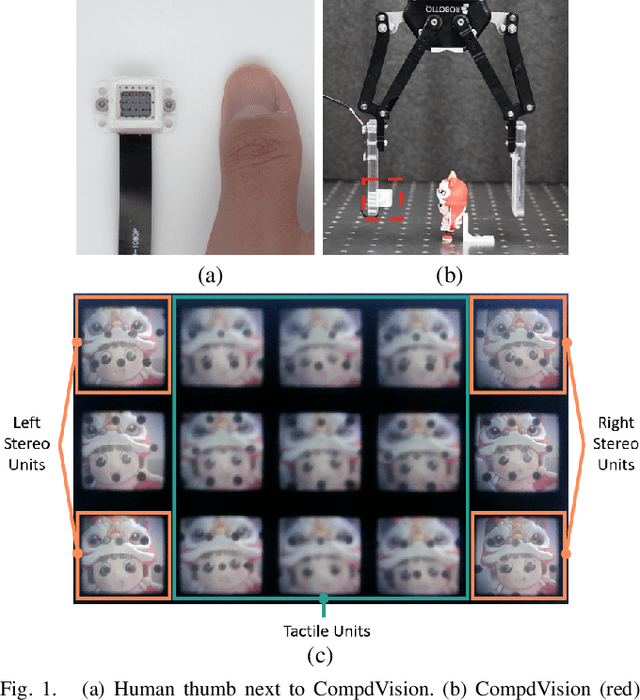
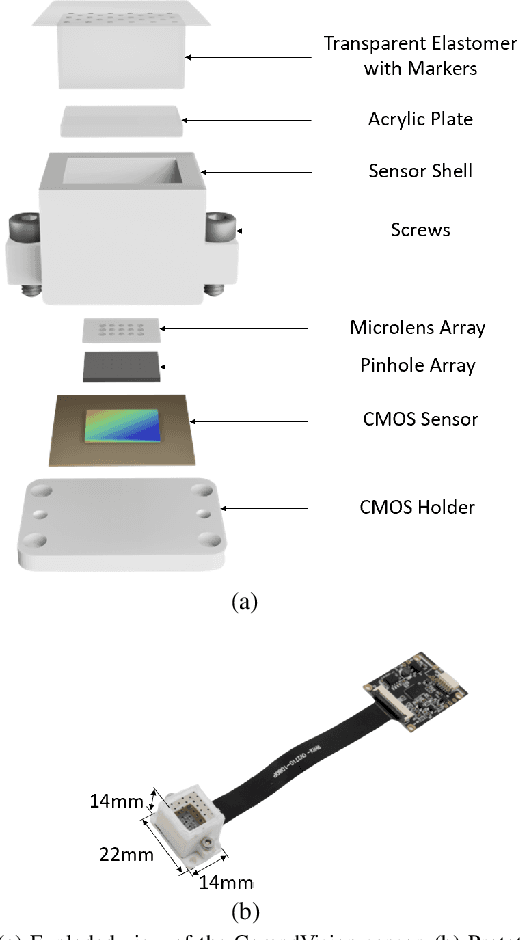
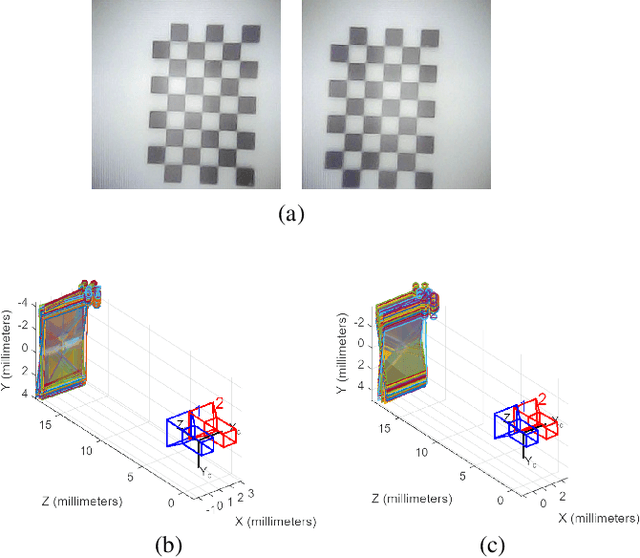

Abstract:As automation technologies advance, the need for compact and multi-modal sensors in robotic applications is growing. To address this demand, we introduce CompdVision, a novel sensor that combines near-field 3D visual and tactile sensing. This sensor, with dimensions of 22$\times$14$\times$14 mm, leverages the compound eye imaging system to achieve a compact form factor without compromising its dual modalities. CompdVision utilizes two types of vision units to meet diverse sensing requirements. Stereo units with far-focus lenses can see through the transparent elastomer, facilitating depth estimation beyond the contact surface, while tactile units with near-focus lenses track the movement of markers embedded in the elastomer to obtain contact deformation. Experimental results validate the sensor's superior performance in 3D visual and tactile sensing. The sensor demonstrates effective depth estimation within a 70mm range from its surface. Additionally, it registers high accuracy in tangential and normal force measurements. The dual modalities and compact design make the sensor a versatile tool for complex robotic tasks.
Reconfigurable, Transformable Soft Pneumatic Actuator with Tunable 3D Deformations for Dexterous Soft Robotics Applications
Nov 06, 2023Abstract:Numerous soft actuators based on PneuNet design have already been proposed and extensively employed across various soft robotics applications in recent years. Despite their widespread use, a common limitation of most existing designs is that their action is pre-determined during the fabrication process, thereby restricting the ability to modify or alter their function during operation. To address this shortcoming, in this article the design of a Reconfigurable, Transformable Soft Pneumatic Actuator (RT-SPA) is proposed. The working principle of the RT-SPA is analogous to the conventional PneuNet. The key distinction between the two lies in the ability of the RT-SPA to undergo controlled transformations, allowing for more versatile bending and twisting motions in various directions. Furthermore, the unique reconfigurable design of the RT-SPA enables the selection of actuation units with different sizes to achieve a diverse range of three-dimensional deformations. This versatility enhances the potential of the RT-SPA for adaptation to a multitude of tasks and environments, setting it apart from traditional PneuNet. The paper begins with a detailed description of the design and fabrication of the RT-SPA. Following this, a series of experiments are conducted to evaluate the performance of the RT-SPA. Finally, the abilities of the RT-SPA for locomotion, gripping, and object manipulation are demonstrated to illustrate the versatility of the RT-SPA across different aspects.
 Add to Chrome
Add to Chrome Add to Firefox
Add to Firefox Add to Edge
Add to Edge